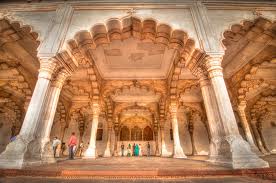Red Fort
Book Now
Red Fort In Agra
 Agra fort, one of the world heritage sites, is really a worth place to visit to view the marvelous architectural beauty in red sandstones and is a place not to be missed by historians and architects. Agra Fort is located near to the Taj Mahal gardens on the banks of River Yamuna. The real specimen of architectural marvel, this fortress was constructed in the 15th century. The construction of this mammoth structure started during 1565 during the Great King Akbar and continued the developments up to the period of King Shah Jahan, the grandson of Akbar. Agra fort, one of the world heritage sites, is really a worth place to visit to view the marvelous architectural beauty in red sandstones and is a place not to be missed by historians and architects. Agra Fort is located near to the Taj Mahal gardens on the banks of River Yamuna. The real specimen of architectural marvel, this fortress was constructed in the 15th century. The construction of this mammoth structure started during 1565 during the Great King Akbar and continued the developments up to the period of King Shah Jahan, the grandson of Akbar.
Architecture of Agra Red Fort
The fort, in a length of 2.5 km marvelous enclosure walls, is built in red sandstones and encloses many monuments which are real architectural wonders. Many exquisite palaces such as the Shah Jahani Mahal, Jahangiri Mahal and the Khas Mahal, and audience halls named Diwan-i-Am and the Diwan-i-Khas are enclosed in the fortress. Other monuments include the Fish Pavilion, the Nagina Masjid, Garden of Grapes and the Pearl Mosque.
 Inside Agra Red Fort Inside Agra Red Fort
After going through the gate you walk over a ramp and enter the Great Courtyard. On the right hand sight, there's the many pillared Diwan-i-Am.
Further you find the Royal Pavilions. It contains beautiful mosques palaces. Several of the buildings are made up of pure marble with beautiful carvings. To cool off the rooms in the marble pavilions, the walls were hollow and filled with running water. From the balconies in the pavilions, you have a nice view on the Yamuna river and the Taj Mahal.
Monument Inside Agra Red Fort
Agra Fort is an astounding structure comprising of, sprawling Palaces, royal private rooms, harems, magnificent towers, bastions, ramparts, and awe-inspiring gateways, showcasing not only the political stature and power of Mughal Empire under Akbar, but also the advancement made in the sphere of art and architecture.
 Jahangiri Mahal is one of the surviving buildings, of Akbar's era, in the Agra Fort. It was a magnificent palace constructed especially for women belonging to the royal household, and was used mainly by the Rajput wives of Akbar. Musamman Burj is famous for its unique ornamentation especially for the awesome pietra dura work. This structure is associated with two famous Mughal personalities Nurjahan and Mumtaz Mahal Jahangiri Mahal is one of the surviving buildings, of Akbar's era, in the Agra Fort. It was a magnificent palace constructed especially for women belonging to the royal household, and was used mainly by the Rajput wives of Akbar. Musamman Burj is famous for its unique ornamentation especially for the awesome pietra dura work. This structure is associated with two famous Mughal personalities Nurjahan and Mumtaz Mahal
Sheesh Mahal was used as the harem dressing room. It was beautifully decorated with glass pieces, hence earned the name Sheesh Mahal.
 Mina Masjid, situated just above the Sheesh Mahal, is enclosed on all the four sides by high walls. This attractive structure was constructed by one of the most prolific builders of Mughal period, Emperor Shahjahan. Mina Masjid, situated just above the Sheesh Mahal, is enclosed on all the four sides by high walls. This attractive structure was constructed by one of the most prolific builders of Mughal period, Emperor Shahjahan.
Diwan-I-khas was the hall of private audience and the emperor used to receive the important dignitaries here. Constructed by Shahjahan, between 1636 and 1637, it is known for its remarkable decoration with pietra dura.
 Diwan-I-Aam was the hall of public audience constructed by Shahjahan. The Emperor used to met officials and commoners here and listened to the petitioners. It was here in Diwan-I-Aam that the famous Peacock Throne was kept. Diwan-I-Aam was the hall of public audience constructed by Shahjahan. The Emperor used to met officials and commoners here and listened to the petitioners. It was here in Diwan-I-Aam that the famous Peacock Throne was kept.
Moti Masjid also known as pearl mosque, is situated to the right of Diwan-i-Aam in the Agra Fort. This magnificent pearl shaped mosque was constructed by Mughal Emperor Shah Jahan.
Visit timings and Price
Time: It opens from 9am to 6pn every day.
Price: Entry ticket costs Rs-11 per person only.
How to reach Agra Fort
By Air: One can easily reach Agra by air. Agra is connected to all the major cities of India through air ways. The 'Kheria' airport is only 6km away from the city center.
By Rail: There are excellent train services from New Delhi. Shatabdi Express, Taj Express and Inter-city Express from Delhi. Other Mail and Express trains are also available from other states. Agra's railway station is Agra Cantonment.
By Road: Many National Highways connect Agra to all major Indian cities. Express and A/C bus services are available from Delhi, Jaipur, Lucknow, Gualior and Jhansi. 'Idgah' is the main bus terminal in Agra.
|